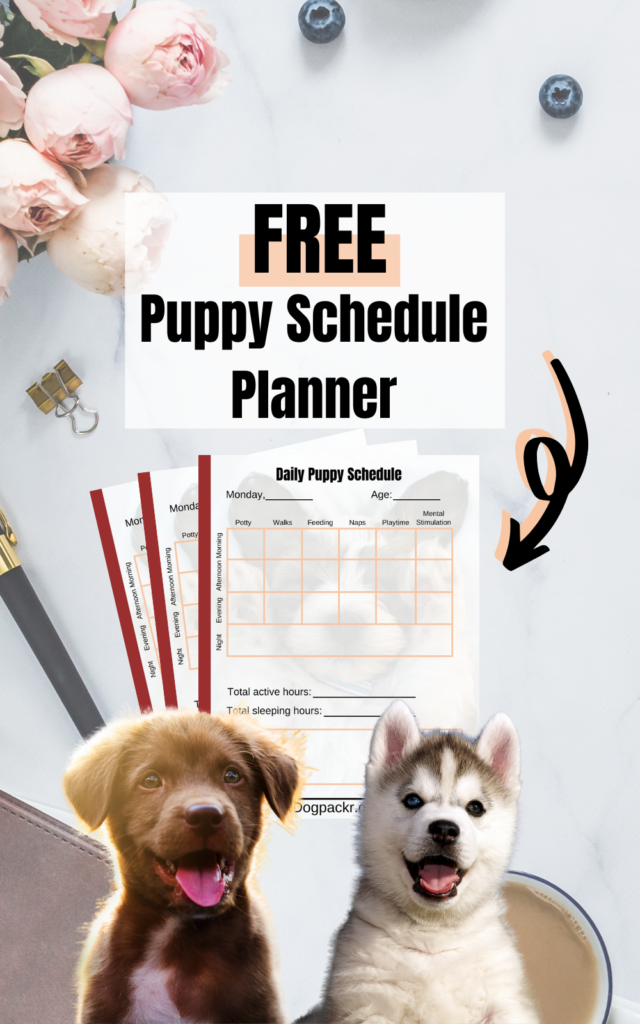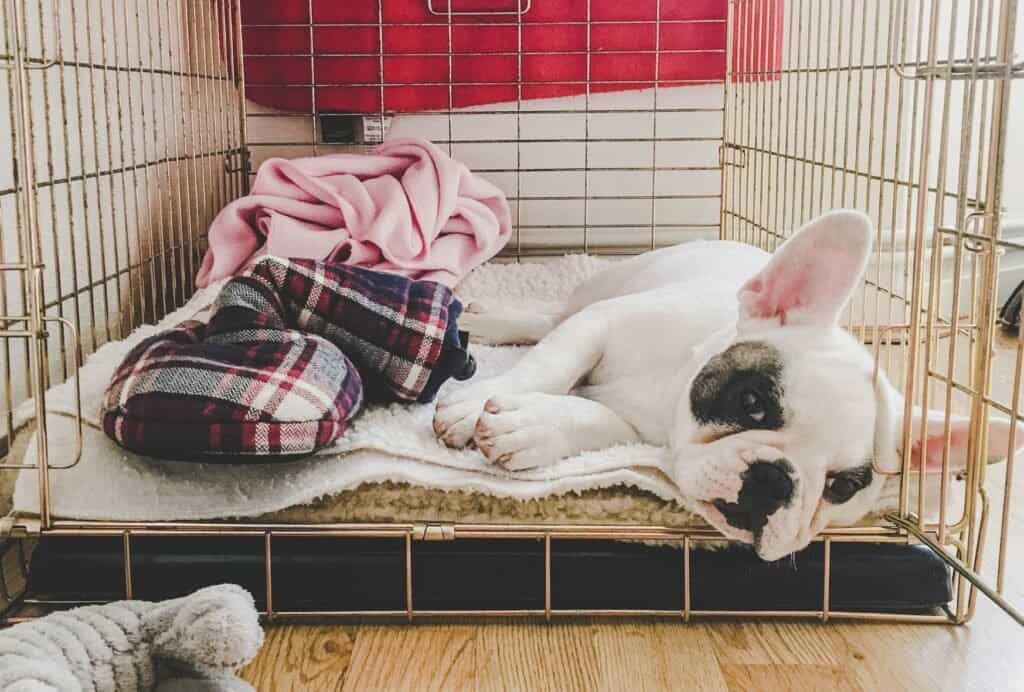
Crates are such wonderful things, and can help you out in a lot of ways. One of the things they’re great for is helping you with potty training your puppy!
Or at least, that’s what you’ve been told. But what about the fact that your puppy keeps peeing in his crate? That’s not supposed to happen, is it?
If you’re feeling frustrated with your puppy peeing in his crate, don’t worry—you’re not alone. You can get him to stop, but first let’s go over why your puppy is peeing in his crate.
Table of Contents
Why Does a Puppy Pee in the Crate?
Okay, so let’s first look at why your puppy is peeing in his crate. Understanding the behavior will make it easier to fix it in a second step.
Can’t Hold His Bladder, Yet
Puppies are a lot like human babies in that they don’t have full control of their bladders quite yet. When you think about how small and young puppies are, it makes sense that they might not be able to hold their bladders for very long at first!
Depending on how old your puppy is, you’ll probably have to take him out of his crate for pretty frequent bathroom breaks during the night. The general rule of thumb is that a puppy can hold his bladder for the number of hours equal to his age in months, plus 1. So, for example, an 8-week old puppy can hold his bladder for 3 hours.
So, if your puppy is peeing in his crate and you’re trying to leave him in there overnight with no bathroom breaks, you might need to adjust your schedule.
You can read more about this in my article “Can a 10-week Old Puppy Sleep Through the Night?”
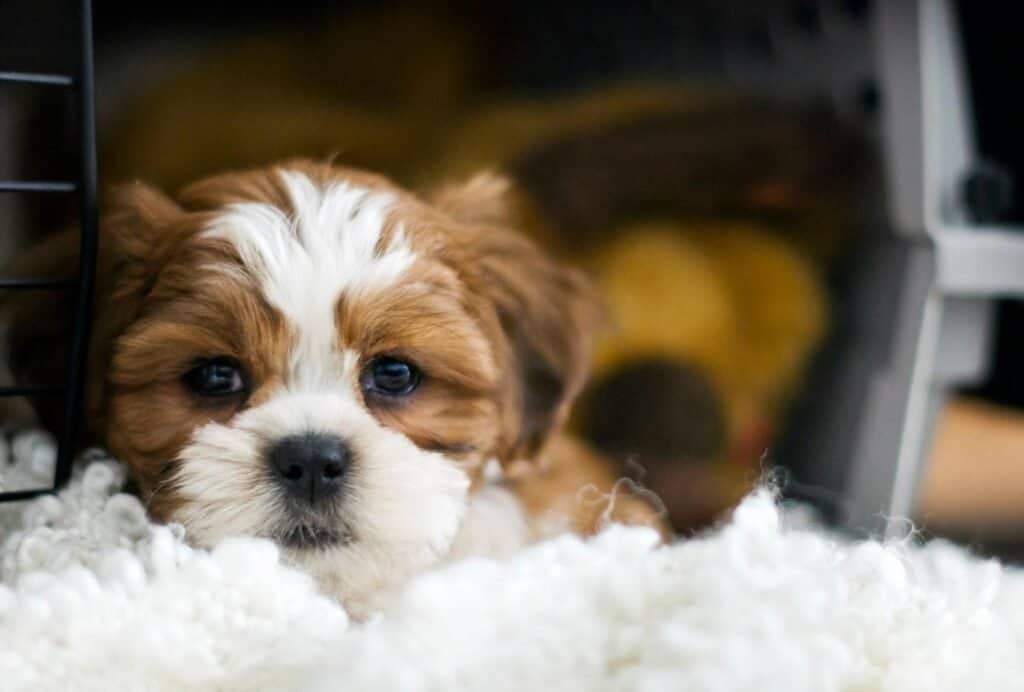
Not Properly Trained
Housetraining a dog is a huge undertaking that can take a long time. Some dogs catch onto it quickly, while others are a little slower.
Your puppy will probably pee in his crate while you’re still working on potty training. That’s normal! Over time, he’ll learn where it is and isn’t appropriate to pee. Just be patient with him—learning all this new stuff is hard work!
Stress or Anxiety
If your puppy is feeling stressed or anxious in his crate, he might pee as part of his stress response. It can be scary for your dog when you first start crate training. That’s why it’s important to go at your dog’s own pace and be patient with him.
Remember, your dog should love his crate, not be scared of it!
If you’re looking for some tips and tricks, here is how to crate train a dog easily in 13 steps.
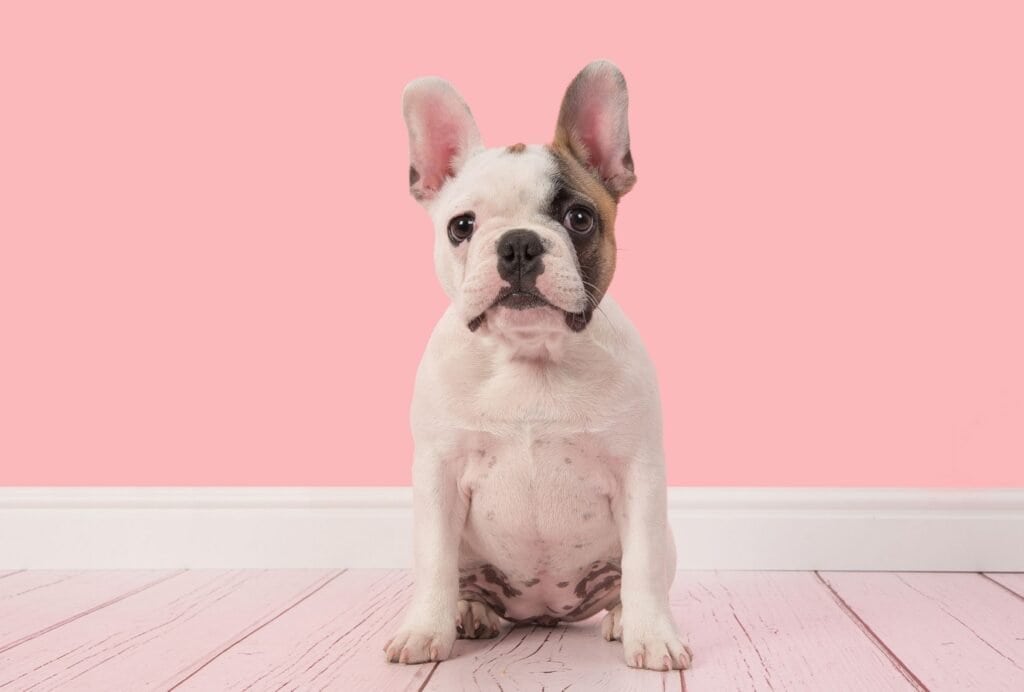
Crate Is Too Big
One of the most important things when you’re choosing a crate for your dog is to make sure it’s the right size. If it’s too small, he’ll be extremely uncomfortable. At the same time, a crate that’s too big gives your puppy room to have accidents.
Your dog’s crate should be big enough that he can stand up fully, turn around comfortably, and not much bigger than that.
If it’s time for you to go crate shopping, here are the 6 best crates for dogs to sleep in.
Medical Issue
Most of the time, a puppy peeing in his crate is just a sign that he has the wrong crate, or his potty training needs a little more work.
Sometimes, however, it can be the sign of a medical issue like a urinary tract infection.
Your dog’s peeing in his crate is most likely the sign of a medical problem if it’s come on suddenly. If he’s been fine until recently, you might want to give your vet a call to get your dog checked out.
11 Tips to Stop a Puppy from Peeing in the Crate
Now that you know why your puppy might be peeing in his crate, here are a few ways you can help him learn to stop!
1. Make Sure He Goes Potty Before He Goes in His Crate
When it’s time for you and your puppy to settle down for bed, you should take him outside right before he goes into his crate. If his little bladder is empty before he goes into his crate, he’ll be less likely to have an accident while he’s in there!

2. Have a Regular Schedule
Having a schedule or routine will help both you and your puppy know when it’s time to go in his crate to rest, and when it’s time to be out and about.
It will also help you track your puppy’s potty times and get to know how his little body works.
Having a schedule is all part of effective crate training. So what’s a good crate training schedule for a puppy? Every dog and owner is different, but this article is a great place to start.
Speaking of schedule, that’s also one of the key elements for a calm dog. Make sure to download my free guide for a calm dog to get the three things you need to know for a relaxed and even-tempered dog.
3. Take His Water Bowl Away 1 Hour Before Bedtime
You should make sure your puppy has access to clean water throughout the day. However, taking it away about an hour before bedtime will help his bladder stay empty and prevent any accidents in his crate. Just make sure to refill his bowl and set it out for him again in the morning!
4. Take Him Out Regularly
As you already know now, puppies can hold their bladders for approximately their age in months plus one. But you’ll probably want to take your puppy outside even more frequently than that!
Taking him out about once an hour throughout the day, at least when he’s very young, will help him learn where it’s okay to potty. It will also help keep his bladder empty once it’s time for him to go to bed!
You can then slowly try to extend the time in between to find your puppy’s “potty threshold”.

5. Make Sure the Crate Isn’t Too Big
Getting a crate that’s the right size is really important. If the crate is too big, your puppy might feel more inclined to potty in one corner, and then sleep in the other.
Make sure the crate is the right size so that he’s comfortable, but not willing to soil it.
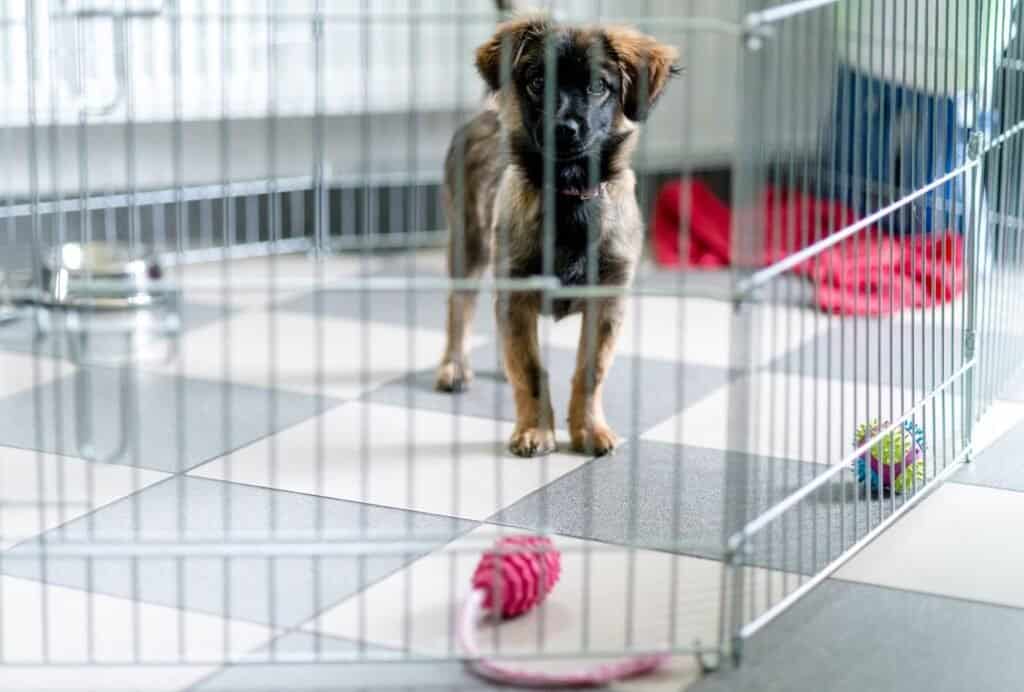
6. Crate Train Him Properly to Reduce Stress
If being in the crate is so stressful for your puppy that he stress pees, you need to start from the beginning!
The most important thing for your dog is that he loves his crate. His crate should be somewhere he feels safe and settles down. So take the training at your dog’s own pace, make sure all your dog’s favorite things happen in the crate, and you’ll see how much he starts to love it.
7. Praise Him for Peeing Outside
The best way to train a dog is with positive reinforcement! This mean ignoring behavior you don’t like, and rewarding behavior that you do.
So every time your dog pees outside, give him a big reward and lots of pats. This will show your dog that you like it when he pees outside, and he’ll feel less like peeing in his crate.
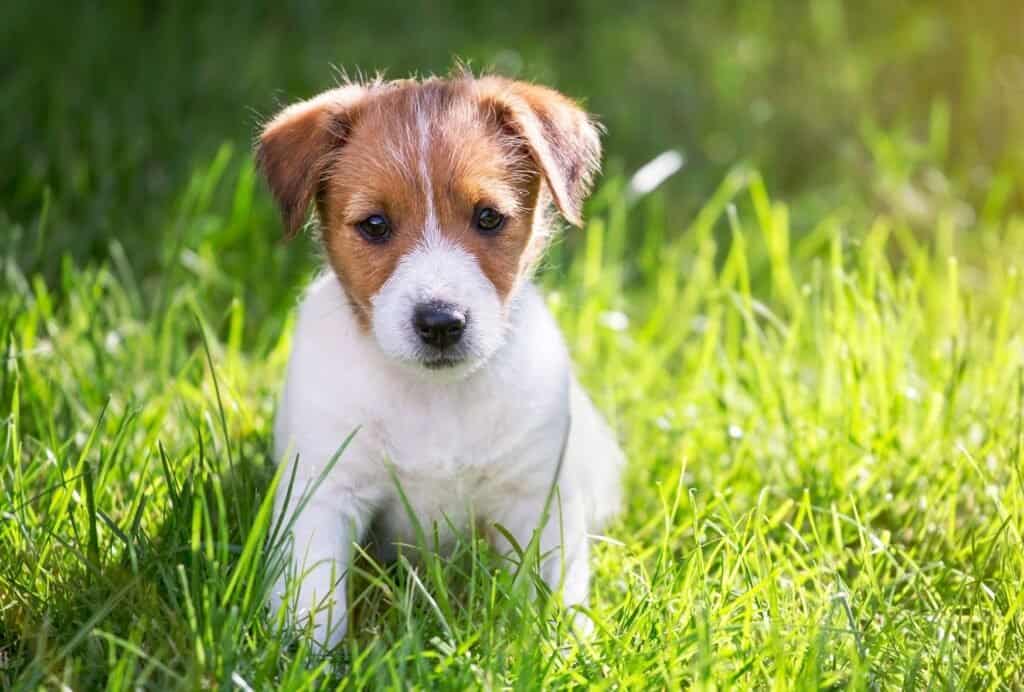
8. Clean the Crate Thoroughly If He Had an Accident
Dogs have really strong noses. They also tend to pee in the same places. If your dog smells the pee in his crate, he’ll think, “There’s already pee here, so it’s okay if I go potty here now.”
It’s really important to clean up as best you can if your puppy’s had an accident in his crate! This will help prevent him from having other ones.
9. Don’t Scold Him After the Accident Happened
You want your puppy to love and trust you, right? It’s important that you don’t scold you puppy after an accident, especially if it happened a while ago!
Your puppy won’t understand why you’re yelling at him, and you might accidentally discourage behavior that’s actually good for him.
If your puppy pees in his crate, you might just need to adjust his schedule. So don’t scold your puppy, do your best to clean up, and figure out what changes you need to make to help your puppy!
10. Be Patient
When puppies pee where they’re not supposed to, it can be really frustrating. But a puppy doesn’t understand where they are and aren’t supposed to pee yet, and it’s your job to help them learn!
Be patient with your puppy. Some puppies progress slower than others, but all puppies can get there. Just remember to be consistent.
Talk to Your Vet
If your puppy seems adamant about peeing in his crate, or his accidents have come on suddenly, you might want to visit your vet.
Even if it’s not a medical problem, your vet will likely have many resources that can help you with your puppy’s potty training.
Conclusion
While puppies peeing in their crates can be really frustrating, it’s also super common. Most of the time, it just means you need to adjust your schedule or work on crate training your dog more.
If your puppy is peeing in his crate, follow these tips to help him learn that it’s not okay to pee there. With patience and consistency, your puppy will stop soiling his crate, and will be much better about peeing outside.
*Disclosure: This post may contain affiliate links, meaning, I get a commission if you decide to make a purchase through one of my links, at no cost to you.

